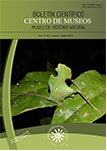Authors
Abstract
Objective: To analize the photosynthetic changes of the species Eichhornia crassipes (Mart.) Solms, Pistia stratiotes L. and Salvinia auriculata Aubl. subjected to a treatment with mining wastewater. Methodology: The plants were exposed to a laboratory-scale treatment with residual water from a mining region of Caldas (Colombia) for six days (144 hours). The main components of the water were determined with Nanocolor test and the photosynthetic changes in the plants during the exposure to the wastewater were determined by spectrophotometric methods. Results: Mining wastewater is a complex matrix whose major component is cyanide (CN-) with a value of 175.00 mg/L surpassing the provisions of the Ministry of Environment and Sustainable Development of Colombia. The relationship of chlorophyll a/b and carotenes/total chlorophyll indicated that the plants E. crassipes and P. stratiotes responded to the treatment by modifying the concentrations of the pigments analyzed. Conclusions: The E. crassipes decreased the chlorophyll a/b ratio as an indicator of stress; the P. stratiotes increased the caroteno/total chlorophyll ratio, increasing the synthesis of carotenes to protect the tissues against stress, and the S. auriculata was the least affected, which translates into a high tolerance or adaptation of the latter species to environmental changes.
Keywords:
References
ASHRAF, M., & HARRIS, P., 2013.- Photosynthesis under stressful environments: An overview. Photosynthetica, 51(2): 163-190.
ÁVILA, O., CASIERRA, F., RIASCOS, D., 2012.- Contenido de pigmentos fotosintéticos en hojas de caléndula bajo sol y sombra. Temas agrarios, 17(1): 60-71.
BAO, A., 2015.- Toxicidad ejercida por el triclosán sobre la microalga dulceacuícola Chlamydomonas moewusii Gerloff: Tesis, Universidad de La Coruña, Facultad de Ciencias, La Coruña.
BASANT, A., MALIK, A., SINGH, K., SINHA, S., 2009.- Multivariate modeling of chromium-induced oxidative stress and biochemical changes in plants of Pistia stratiotes L. Ecotoxicology, 5(18): 555-566.
CALLEJAS, K., CONTRERAS, A., MORALES, L. & PEPPI, C., 2013.- Evaluación de un método no destructivo para estimar las concentraciones de clorofila en hojas de variedades de uva de mesa. Idesia, 4(31): 1-25.
CAMBRÓN, V., HERRERÍAS, Y., ESPAÑA, M., SÁENZ, C., SÁNCHEZ, N. & VARGAS, J., 2011.- Producción de clorofila en Pinus pseudostrobus en etapas juveniles bajo diferentes ambientes de desarrollo. Revista Chapingo serie ciencias forestales y del ambiente, 17(2): 253-260.
CRUZ, A., FORTES, D., HERRERA, R., GARCÍA, M., GONZÁLEZ, S. & ROMERO, A., 2009.- Comportamiento de los pigmentos fotosintéticos, según la edad de rebrote después del pastoreo de Pennisetum purpureum vc. Cuba CT-115 en la estación poco lluviosa. Revista Cubana de Ciencia Agrícola, 43(2): 183-186.
DHIR, B., & SRIVASTAVA, S., 2013. - Heavy Metal Tolerance in Metal Hyperaccumulator Plant, Salvinia natans. S. Bull Environ Contam Toxicol, 90: 720.
DHIR, B., KUMAR, R., MEHTA, D., SARADHI, P., SHARMA, A., & SHARMILLA, P., 2011. - Heavy metal induced physiological alterations in Salvinia natans. Ecotoxicology and Environmental Safety, 6(74): 1678-1684.
EBEL, M., EVANGELOU, M. & SHAEFFER, A., 2007. - Cyanide phytoremediation by water hyacinths (Eichhorniacrassipes). Chemosfere, 66(5): 816-823.
FARNESE, J., GUSMAN, G., LEAO, G. & OLIVEIRA, J., 2013.- Evaluation of the potential of Pistia stratiotes L. (water lettuce) for bioindication and phytoremediation of aquatic environments contaminated with arsenic. Braz J Biol, 3(74): 1201-1209.
FASIDI, I. & ODJEGBA, V., 2004.- Accumulation of Trace Elements by Pistia stratiotes: Implications for phytoremediation. Ecotoxicology, 7(13): 637-646.
FLORES, E. & JARAMILLO, M., 2012.- Fitorremediación mediante el uso de dos especies vegetales Lemnaminor (Lenteja de agua), y Eichhornia crassipes (Jacinto de agua) en aguas residuales producto de la actividad minera: Tesis, Universidad Politécnica Salesiana de Ecuador, Cuenca-Ecuador.
FLORES, M., GUERRERO, J. & VERGARA, F., 2011.- Efecto del tiempo de almacenamiento y tipo de procesamiento en los antioxidantes de nopal. Temas selectos de ingeniería de alimentos, 5(2): 84-96.
GOEL, N., HARRON, J., HU, B., MILLER, J., MOHAMMED, G., NOLAND, T., SAMPSON, P. & ZARCO, P., 2004.- Needle chlorophyll content estimation through modelling version using hyperspectral data from boreal conifer forest canopies. Remote Sensing of Environment, 89(2): 189-199.
GÓMEZ, J., MONROY, O., OLGUÍN, E., SÁNCHEZ, G., 2008. Assessment of the hyperaccumulating lead capacity of Salvinia minima using bioadsorption and intracellular accumulation factors. Water, Air and Soil Pollution, 1(194): 77-90.
GONZÁLEZ, A., 2009.- Aplicación del medidor portátil de clorofila en programas de mejora de trigo y cebada. Agroecología, 4: 111-116.
GONZÁLEZ, J., HILAL, M., PAGANO, E., PRADO, C., PRADO, F. & RODRÍGUEZ, L., 2010.- Uptake of chromium by Salvinia minima: Effect on plant growth, leaf respiration and carbohydrate metabolism. Journal of Hazardous Materials, 1-3(177): 546-553.
HANOVER, J. & TOWNSEND, A., 1972.- Altitudinal variation in photosynthesis, growth, and monoterpene composition of western white pine (Pinus monticola Dougl.) seedlings. Silvae Genetica, 21(3-4): 133-139.
KUMAR, N., RAI, N., SINGH, R., & TEWARI, A., 2008.- Amelioration of municipal sludge by Pistia stratiotes L.: Role of antioxidant enzymes in detoxification of metals. Bioresource Technology, 18(99): 8715-8721.
LARA, J. & MARTELO, J., 2012.- Macrófitas flotantes en el tratamiento de aguas residuales: una revisión del estado del arte. Ingeniería y Ciencia, 8(15): 221-243.
MAITI, D. & PRASAD, B., 2016.- Comparative study of metal uptake by Eichhornia crassipes growing in ponds from mining and non-mining areas: a field study. Biorem. J, 2(20): 144-152.
RASHED, M., & SOLTAN, M., 2003.- Laboratory study on the survival of water hyacinth under several conditions of heavy metal concentrations. Advances in Environmental Research, 7(2): 321-334.
SERRANO, M., 2006.- Fitorremediación: una alternativa para la recuperación de suelos contaminados por hidrocarburos. Universidad Industrial de Santander. Escuela de Química.

 PDF (Español)
PDF (Español)
 FLIP
FLIP



















